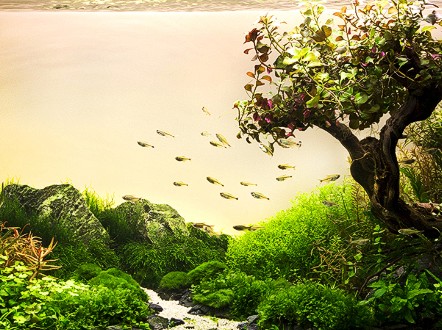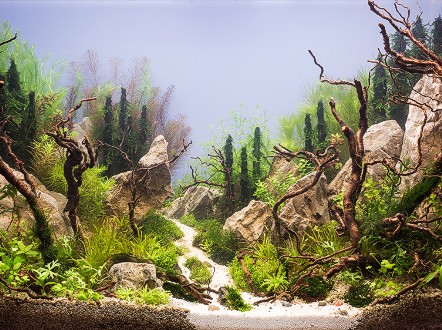When it comes to pimping out a fish tank, a novice might purchase a bag of brightly colored gravel and a few plastic ornaments.
For Dan Crawford, a founding member of the UK Aquatic Plant Society (UKAPS), that simply will not do.
He and a growing number
of "aquascapers" are creating underwater marvels that require knowledge
of biology and design—not merely kitsch fish trinkets.
Using rocks, wood,
fern-like plants, special lighting, and plenty of creativity, they are
dreaming up seascapes that would leave Poseidon in awe.
It's relaxing, it's artistic, it's scientific and when done correctly it creates a piece of living art
Dan Crawford, founding member of the UK Aquatic Plant Society
Dan Crawford, founding member of the UK Aquatic Plant Society
"For me aquascaping ticks
a lot of boxes," Crawford says. "It's relaxing, it's artistic, it's
scientific and when done correctly it creates a piece of living art."
For competitive aquascapers, their art goes on show at international aquascaping contests like Russia's International Planted Aquarium Design Contest and the International Aquascaping Contest put on by the Houston-based Aquatic Gardeners Association (AGA).
Competitive designs may
invoke the Wild West and include submerged cacti, or recreate the taiga
of Russia, the valleys of China, or even lost beaches.
Cheryl Rogers, the president of the AGA, says the desire to innovate leads to a familiar pattern among aqua gardeners.
"For purposes of
competition, most aquascapers of winning caliber create a layout, grow
it to peak in a few months, snap the photos for competition, then tear
it down and create a new one," she says "This is what they do for fun."
Global interest
Interest in aquascaping is particularly strong in Asia.
Takashi Amano, the noted
Japanese landscape photographer, helped popularize the hobby in Japan
in the mid-1990s with his three-part book series Nature Aquarium World.
Westerners have been slower to latch onto the pursuit—and are often seen as slightly kooky when they do.
"It's a very specialized
hobby and because of this it's rare that you'll bump into a fellow
aquascaper in the local pub or coffee shop," says Crawford. "Generally
we will convene at a chosen Aquatic Shop for a chin wag and a look
around then move on to the pub to talk about the latest trends and
'scapers."
Courtesy all4aquarium.ru
But today the Internet
is helping grow the activity. Web sites connect existing enthusiasts who
exchange tips and tricks, and help newbies learn the basics of building
their very own marine masterpiece.
Started eight years ago, the UKAPS web site now clocks more than six million page views per month and has 9,000 registered members.
In the online forum they
discuss topics like the best water filtration systems, appropriate
lighting, why their shop-bought plants are failing to flourish and how
to add Java moss to an aquarium.
You can have a lovely planted tank in your living room that pleases you, even if it would never win a competition
Karen Randall, author and aquascaping competition judge
Karen Randall, author and aquascaping competition judge
Sometimes it's a matter of life a death. As one user recently asked in the forum: "Does copper in fertilizer kill shrimp?
Suppliers are also waking up to the opportunities to cater to the aquascaping community.
Read more: Life of a muse: What is it like to inspire art for a living?
Rogers of the AGA says
these retailers are helping aquascapers source the plants and materials
they need to make their gardens grow.
"Unless you have a local
pet store in your area that specializes in our little corner of the
hobby, it's difficult to find quality plants, or new plants, or rare
plants," she says. "So we get our plants from other hobbyists and online
retailers."
Master aquascaping requires a lot more than goldfish and plastic rocks.
Among other things,
enthusiasts must stock their supply cabinets with algaecide products
that help control green water and systems that supply plants with the
carbon dioxide they need to stay alive.
Art in a box
Mastering the hobby takes time.
Karen Randall, an author
who has judged several international aquascaping competitions, says
that aquascapers approach their work like any other artist would. They
have to think about the rule of thirds, areas of negative space, and how
best to utilize colors, texture and form.
Rocks and wood
formations create the "hardscape", which is used to support the plants
in the aquarium. The hardscape also helps set parameters for the rest of
the design.
"In the terrestrial
garden, the gardener usually has to think more about the natural terrain
he or she has to work with, along with large trees and buildings, and
work those into the design," she says. "In aquatic gardening, the only
thing we start with is four glass walls."
Judging art is always subjective. But competition organizers do their best to ensure fairness and impartiality.
Courtesy all4aquarium.ru
For the Planted Aquarium
Design Contest 2013, organizers brought together an international jury
of nine aquascapers and aquarium designers from countries including the
Czech Republic, Poland, and Turkey.
Judges praise and criticize aquariums in equal measure.
Critiquing "Charm of
light", a tank submitted by a Turkish aquascaper, one judge applauded
its use of back lighting and left side reflection.
He still saw room for
improvement: "White gravel and shape of small stones is inconsistent
with bigger rocks and forest soil layer in nature. I would like to see
some fishes or invertebrates in this tank."
Competitions promote
interest in the hobby and give enthusiasts a platform to share their
love of aquariums. But aquascapes don't have to impress a jury to create
a sense of Zen.
"You can have a lovely
planted tank in your living room that pleases you, even if it would
never win a competition," Rogers says. "Most hobbyists are not
competitors. They just like plants."
















0 comments:
Post a Comment